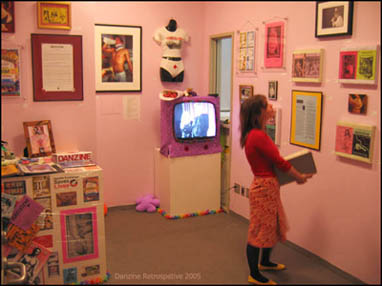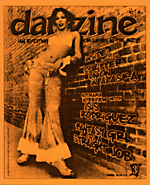
|
||
|
Portland art blog + news + exhibition reviews + galleries + contemporary northwest art
|
||
David Velasco on Danzine at CUNY  A brief disclosure. On those toxically quixotic summer days spent botanizing the pavement of downtown Portland, I would sometimes spy Danzine editrix Teresa Dulce strolling down Stark Street or Broadway wearing her assertive "Hooker" baby-tee, and I would stop and whisper to myself: "I love you." I wasn't the only one who cultivated a distant admiration of Dulce; she sparked quite a fan club in PDX and beyond. As the principal face of Danzine (1995-2005), an organization that taught us all that sex workers aren't faceless, she and the rest of her crew channeled an unbridled sense of strength, care and hospitality. Recently, I was fortunate enough to catch some of this energy at an installation and Danzine retrospective Dulce and cohort Marne Lucas put together for the group show At the Mercy of Others: The Politics of Care at New York's CUNY Graduate Center (curated by Sasha Archibald, Sarah Lookofsky, Cira Pascual Marquina and Elena Sorokina for The Whitney Independent Study Program - ended June 25, 2005). Mobilizing some of the elite attack squad of contemporary artists from the 60s through the new millennium, the show worked to demonstrate the impossibility of a true and noble act of caring, while nevertheless underlining the necessity of the work of care. A triple-play of Mary Kelly's Primapera, Mike Kelley's More Love Hours Than Can Ever Be Repaid and film footage of Yoko Ono's Cut Piece showed some curatorial ingenuity, successfully weaving together themes of caring, cutting, and dependency without tugging or gnarling the fabric of the show. This combination contrasted poorly, however, with Sophie Calle's Exquisite Pain, Day 6, a gorgeous piece comprised of two tapestries and photos commemorating the artist's and a stranger's pain, which stuck out like a flamingo in a flock of geese in an exhibition that leaned towards a less polished documentary aesthetic. Adrian Piper's Ur-Mutter #5, which compared a magazine portrait of an indigent mother and child with a photo of the couple's healthy American counterpart was, if a bit didactic, honest and effective, and a nice complement to AA Bronson's similarly blatant but more therapeutic (and perhaps more challenging) Testimonial #2. 
Documentation (the care of history maybe?), became less an aesthetic concern and more a practical one in Dulce and Lucas' installation, and amidst all the heavy-hitters, Danzine shined. Easily the riskiest of the pieces in the show, the to-scale recreation of "Switzerland," Danzine's in-house safe space, demonstrated the organization's inclusive attention to sex workers and gallery-goers alike. Sitting on a rug in this snug satellite of the main gallery watching videos of confrontations between The Scarlet Letter and Portland's City Council and footage of Dulce instructing (with props) an audience on how to use a "female" condom, I was forced to consider Danzine's uniqueness. Very few organizations managed to trumpet so many daringly progressive causes for so long, and outside of the strip-club saturated liberal environs of Portland (with perhaps the exceptions of San Francisco and Amsterdam), I wonder how long they would've been able to turn their trick. Free rubbers lying on a table didn't just embody care in its practical materiality, they also evoked Felix Gonzalez-Torres's Placebo (an installation of which was cut from the Care show due to spatial demands), and Lucas's Philip-Lorca diCorcia-inspired photograph of a young hunk dribbling milk down his chest was as prurient as it was compelling. Other pieces by artists Fishy, Dawn J., Christina LeBlanc-Stanley, Lara Lee, Scott Nasburg, Arnold Pander, Leslie Peterson, Bryan Pollard, Suzanne Shifflett, Stosh, Sean Tejaratchi, Melissa Tremblay, Ernest Truely, Gina Velour, Kristin Yount celebrated a wide range of aspects of sex worker life using craft, collage and photography. The sincere communal sentiment of the installation was a welcome relief in New York, where many artists are far too fettered by anxiety over commercial appeal to be truly generous. NYC based guest writer David Velasco (a former Portlander) recently penned an article on the artist David Altmejd in the current July/August issue of Art Papers magazine. Posted by Guest on July 09, 2005 at 19:08 | Comments (0) Comments Post a comment Thanks for signing in, . Now you can comment. (sign out)
(If you haven't left a comment here before, you may need to be approved by
the site owner before your comment will appear. Until then, it won't appear
on the entry. Thanks for waiting.)
|
| s p o n s o r s |
 |
 |
 |
 |
 |
 |
 |
 |
 |
 |
 |
 |
 |
 |

|
Site Design: Jennifer Armbrust | • | Site Development: Philippe Blanc & Katherine Bovee | |

